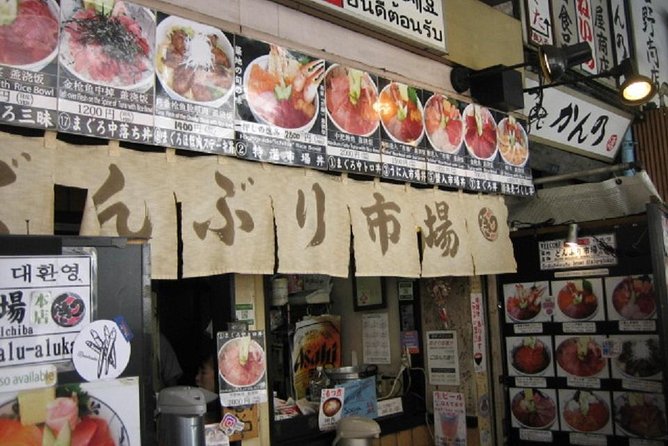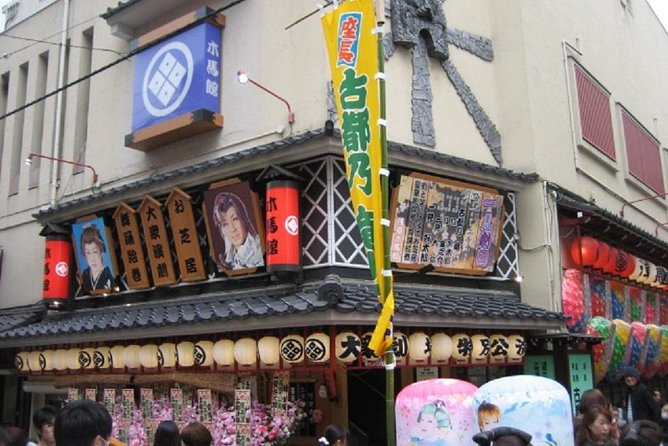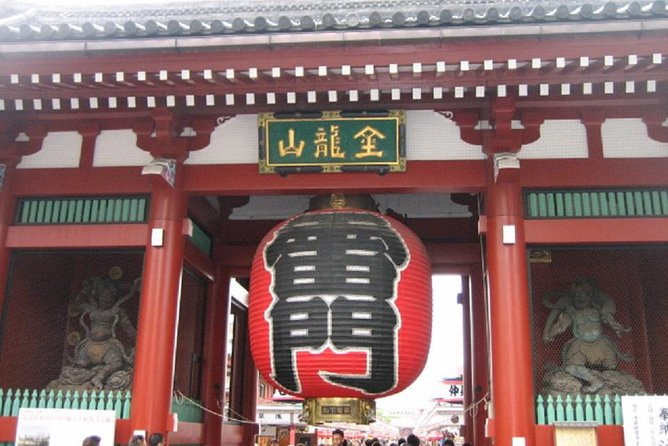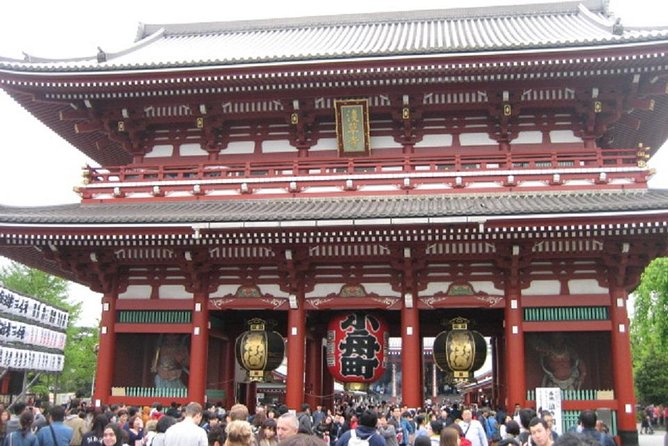Nestled in the heart of Tokyo, Tsukiji and Asakusa stand as two major complexes that beckon travelers with their distinct offerings.
While Tsukiji’s bustling market scene and Asakusa’s serene temples may seem worlds apart, both locales share a common thread of cultural richness waiting to be explored.
But what hidden treasures lie within these historic sites, and what tales of the past do they hold?
Stay tuned to uncover the captivating allure of Tsukiji and Asakusa, where traditions meet modernity in a harmonious blend.
Just The Basics

- Tsukiji and Asakusa offer a blend of traditional and modern experiences for visitors.
- Viator provides essential information and tours for exploring Tsukiji and Asakusa.
- Clear directions and navigation options ensure easy access to both complexes.
- Detailed exploration reveals historical landmarks and cultural wonders in Tsukiji and Asakusa.
Here's some other great tours and experiences nearby we think you'll like.
Tsukiji and Asakusa Overview
With rich cultural heritage and historical significance, Tsukiji and Asakusa stand as popular tourist spots in Japan. Both locations offer a unique blend of traditional and modern experiences, making them ideal destinations for those seeking a rich history and cultural experience.
Tsukiji, known for its former fish market and now bustling shopping district, allows visitors to enjoy the vibrant local culture. Asakusa, on the other hand, boasts the famous Senso-ji Temple, offering a glimpse into Japan’s ancient past.
From exploring traditional markets to witnessing historic landmarks, Tsukiji and Asakusa provide travelers with an authentic Japanese cultural experience that’s both enriching and memorable.
Viator Information

Tsukiji and Asakusa, renowned for their cultural significance and historical allure, connect visitors to Viator’s essential information hub. Viator offers assistance through their Help Center, where inquiries can be made regarding the terms and conditions of their services. Visitors can find valuable details about Viator’s operations, including the product code 122630P1. The pricing details for tours vary, with costs starting at $155.31. Understanding Viator’s offerings is crucial for a budget-friendly exploration of Tsukiji and Asakusa. Explore the table below for further insights:
| Viator Information | Details |
|---|---|
| Help Center | Inquiries and assistance provided |
| Product Code | 122630P1 |
| Terms & Conditions | Information on Viator’s policies |
| Pricing Details | Starting at $155.31 |
| Copyright | © 1997-2024 Viator |
Directions and Navigation

For efficient exploration of Tsukiji and Asakusa, visitors can rely on clear guidance and detailed instructions provided for easy navigation to these historical complexes. Map assistance is available to help travelers orient themselves within the areas.
When it comes to transportation options, both complexes are well-connected by public transport, offering visitors convenient access. Tsukiji and Asakusa can be easily reached by train or bus, making it simple for travelers to move between these significant locations. By utilizing the provided maps and exploring the various transportation choices, visitors can make the most of their time in Tsukiji and Asakusa without the need for expensive private tours.
Efficient navigation ensures a smooth and enjoyable experience while discovering these cultural gems.
Exploration Details

Visitors can explore the captivating history and cultural wonders of Tsukiji and Asakusa through detailed exploration of their tourist attractions. Both complexes boast a wealth of historical landmarks and cultural experiences for visitors to enjoy.
Tsukiji’s famous fish market, where centuries-old traditions meet modern commerce, offers a unique glimpse into Japanese culinary culture. Meanwhile, Asakusa’s iconic Senso-ji Temple stands as a testament to Japan’s spiritual heritage, attracting pilgrims and travelers alike.
Miscellaneous
Curious about the terms and conditions for exploring Tsukiji and Asakusa? Tourist inquiries regarding these locations are welcomed. It’s essential to be aware of the site regulations when visiting these major complexes in Japan.
Understanding the rules and guidelines ensures a smooth and enjoyable experience. Whether it’s about photography restrictions, opening hours, or specific areas that require special attention, having this information beforehand can prevent any misunderstandings during your visit.
Remember to respect the cultural heritage of these sites by following the established regulations. By staying informed and adhering to the guidelines, visitors can contribute to the preservation and appreciation of Tsukiji and Asakusa’s historical significance.
Cultural Heritage Highlights

Highlighting the rich cultural heritage of Tsukiji and Asakusa, visitors can enjoy centuries-old traditions and historical significance at these iconic Japanese complexes.
Tsukiji boasts cultural traditions through its renowned fish market, where visitors can witness the lively auctions and traditional practices of fishmongers.
Asakusa, on the other hand, showcases architectural wonders like the historic Senso-ji Temple, a symbol of Japan’s religious heritage with its stunning pagoda and intricate designs.
Both complexes offer a glimpse into Japan’s past, allowing visitors to appreciate the country’s rich cultural tapestry. From the intricate details of the architecture to the time-honored traditions still practiced today, Tsukiji and Asakusa are cultural gems waiting to be explored.
Historical Significance Insights
The historical significance of Tsukiji and Asakusa unveils a tapestry of Japan’s past, weaving together centuries-old traditions and architectural marvels that beckon exploration.
-
Architectural Marvels: The intricate designs of temples and buildings in Asakusa showcase the craftsmanship and attention to detail of ancient Japanese architecture.
-
Cultural Traditions: Tsukiji’s longstanding role as a hub for fresh seafood markets and traditional tea houses reflects Japan’s deep-rooted cultural practices and culinary heritage.
-
Historical Insights: Exploring these complexes provides a firsthand look at how historical events and cultural influences have shaped the vibrant tapestry of Japan’s past, offering visitors a window into the country’s rich history and traditions.
Frequently Asked Questions

Are There Any Specific Dress Codes or Cultural Etiquette to Be Aware of When Visiting Tsukiji and Asakusa?
Cultural norms and dress codes vary in different places. It’s essential to research these aspects before visiting to show respect. Being mindful of local customs can enhance the experience and ensure a smooth exploration.
Are There Any Recommended Local Restaurants or Food Stalls to Try in Tsukiji and Asakusa?
When exploring Tsukiji and Asakusa, visitors can savor street food and local eats at various spots. Culinary delights and hidden gems await, offering a budget-friendly taste of authentic Japanese cuisine in these historical locations.
Can Visitors Participate in Any Traditional Ceremonies or Activities While Exploring Tsukiji and Asakusa?
Visitors can engage in participatory ceremonies and traditional activities while exploring Tsukiji and Asakusa. These immersive experiences enrich cultural understanding and provide a unique connection to Japan’s heritage. Enjoy the rich traditions on a budget-friendly adventure.
Are There Any Special Events or Festivals That Take Place in Tsukiji and Asakusa Throughout the Year?
Throughout the year, visitors can enjoy seasonal celebrations, cultural performances, and interact with local artisans at special events in Tsukiji and Asakusa. Street markets offer unique experiences, making these locations vibrant and dynamic.
Are There Any Hidden Gems or Lesser-Known Attractions in Tsukiji and Asakusa That Are Worth Exploring?
Exploring hidden gems, local markets, cultural experiences, and off the beaten path attractions in Tsukiji and Asakusa offers a unique adventure. Visitors can discover lesser-known spots, savor authenticity, and explore the heart of Japanese culture.
Final Words
To sum it up, Tsukiji and Asakusa offer a rich cultural experience with their culinary delights, historical landmarks, and traditional charm. Visitors can easily navigate these complexes with the help of clear directions and insightful exploration details.
Both locations are budget-friendly and provide a glimpse into Japan’s past and present. Don’t miss out on the opportunity to explore the hidden gems and historical significance of Tsukiji and Asakusa on your next trip to Japan.
